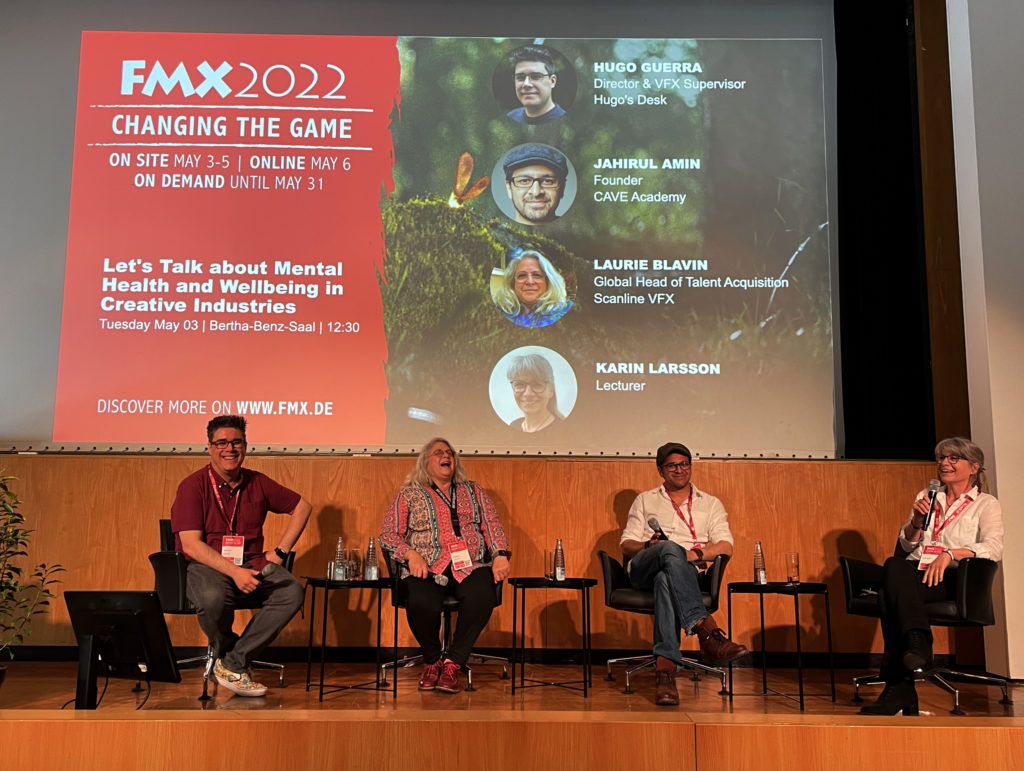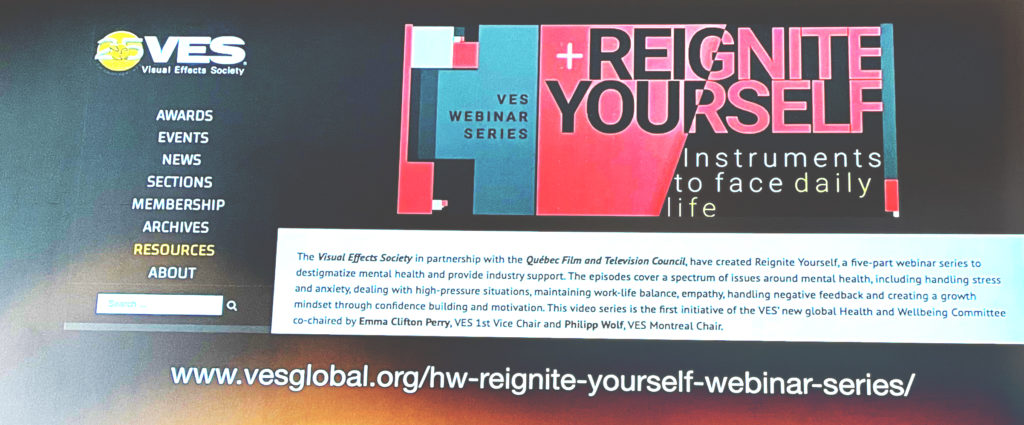
I am sorry: It is a long read.
Sometimes there are panels that are so important that no one notices. They are life-saving. This panel from the Social Impact Category called „Lets talk about Mental Health and Wellbeing in Creative Industries“ is just such a panel.
Hugo Guerra (Hugo’s Desk), Laurie Blavin (Scanline VFX), Karin Larsson, Lecturer and Jahirul Amin (CAVE Academy) talk about the long-tolerated problems of employees in the creative industries
The four speakers know their stuff.
Laurie Blavin as Global Head of Talent Acquisition of 1300 employees. A huge business with locations all over the world. Hugo Guerra. His filmography is so long that the author gets bored just scrolling down his portfolio on the website. He has been everywhere. At The Mill, Fire Without Smoke, Sony Playstation or Rebellion Games. Jahirul Amin. He is founder of CAVE Academy, which specialises in VFX, animation and games training for the creative industry. Before launching CAVE Academy, he was the VFX Trainer at DNEG London, and before that, a lecturer in Computer Animation at Bournemouth University. Karin Larson has a PhD in psychology and has worked in the USA for many years. She is a lecturer at the Filmakademie Baden-Württemberg in Ludwigsburg and covers the topics how to build a successful team, solve problems in team situations and be able to enjoy a productive team. She specialises in the needs of employees in the creative industries.
All four of them know what they are talking about and illuminate the topic from many angles, be it from the point of view of the people concerned to that of the psychologists.
Questions are asked such as „How can you stand working in this industry? This stress, the hard deadlines, the long hours, the working conditions and sometimes environments?“
Most people can’t take it. Concentration problems, health problems of too much sitting, the long hours where you have to be awake all the time. When you’re young you put up with it, but not so when you’re older.
People get sick, they lose themselves in work, they don’t find an end, they work more and more and finally they don’t know who they are, what they can do, what they used to be and what they want to be. They work, let themselves be driven by deadlines and demands until they simply collapse. It is an industry comparable to slave labour. 16 hours is no problem, so is weekend work, last minute time changes, nights without sleep at the computer and sleepless nights because you can’t switch off anymore.
How is it that an industry can provoke such reactions in its employees? Surely it is because of the glamorous side of this world. People work for the film industry. There are stars to be found there. Stars in every trade, be it cinematographers, actors, special effects artists, sound artists, costume etc. dreams are built here and it is from the fascination of the never before seen, lived, thought and dreamed that the creative industries thrive. They provide the food to break out of reality, to do a bit of escapism. Whoever plays in this industry is part of this entertainment machinery, full of artists and deviant professions and specialists. It’s like a secret industry, because most people don’t even understand what the titles and work units do and mean.
That’s why myths can be played with. At the conferences, young people stand on a podium and tell how they designed and produced this or that character. What it took to make a lifelike virtual character with wings, fur made of water particles or streams of fire or other fantastic attributes.
They talk about joints, rigging, how many studies were needed, which templates were necessary for motion tracking and what was thought of and done to integrate the light on the surface of a completely virtual art character into a real film scene. It’s a pleasure to listen.
You want to be fooled too much and become a part of it. One also wants to tell about the fact that one has made a tremendous effort, that one has not failed at problems, but that all of them have been solved. That the result yielded an OSCAR or an EMMY Award, that one had a part in such a production and appears in the credits. Fame and glory, unfortunately not enough money and time. It’s a kind of secret society. And as it is with such societies, many other aspects remain in the dark.
And so it is that it is almost a „badge of honour“ in the industry to have a burn out. The fact that burn-out is a serious mental illness that those affected carry with them throughout their lives and always have to deal with is not addressed. „That should not be the case. You have to keep your creativity alive, and that only works if you are healthy. So please: get away from the screen“. (Laurie Balvin)
The poor pay, the pressure to hand over creative work in bulk, to have the good idea, to be able to realise it accordingly with the manifold tools, to always have a solution ready. Perhaps it is the fear of not being noticed by the creative director or of receiving a crushing critique from the art director, only to be demoted as a consequence. (Hugo Guerra)
It is the dichotomy of wanting to go home after 8 hours of hard and concentrated work, to enjoy a private life. But that’s not easy, because all the other colleagues are still at their desks and computers. You don’t want to leave anyone behind, you don’t want to set boundaries. These industries exploit and the creatives let themselves be exploited. The young creatives go to the limit of their pain. They don’t have enough self-confidence yet to stand up for themselves. (Jahirul Amin)
In addition, there is often the family saga of the company. The workers are told that they are one big family. Families share pain and joy. People are there for each other. But is that true? Agencies, companies want to, have to make turnover. The family story is used against the employees like in mafia structures. Either you are one of us, or you are against us.
There are a lot of circumstances that lead to employees giving up on themselves. And realise far too late that they no longer have any friends, that they don’t do any sport, that they eat badly, maybe even develop moderate illnesses due to bad posture after 17 hours of sitting and staring at the computer, that they wake up in the middle of the night thinking about work, that they have no motivation, that they only want to be at work. Because that is where they always are, where they are at home. People forget what it means to clear their heads, maybe to read, or to go for a walk. Or even join a sports club, raise a family, visit friends and pop in for a coffee or tea without pressure. To experience time. Or to enjoy boredom.
The panel deals with this problem.
Karin Larsson tells us that a position has been created in the productions of the film academy that deals with the welfare of the participants. An astonishing statement in the eyes of the author. Almost unimaginable, in fact. She reports that the artists are reminded to sleep, take breaks, get air, eat and experience community. Is it not
unfortunate that we are in a world of work where one has to be reminded of such fundamental needs?
Yes it is. It is perhaps due to the nature of the artistic profession. Intrinsic motivation drives action, it’s no longer mainly about money, a big company car or the bonuses. It’s about art, culture, the greater good. That drives employees and that is very fertile ground for exploitation.
In this panel, all that is spoken and named. What has a name gets a face. There are ways out. There are already support organisations such as Health and well-being resources in the visual effects Industry. In webinars, the silverbacks talk about their experiences in the creative industries, how they coped with the problems, what solutions they developed.

www.vesglobal.org/hw-reignite-yoursself-webinar-serien/
Hugo Guerra: „It was great to work 16 hours and more. You were even admired and praised for it. At the same time, you feel like a working robot. Physical, mental and psychological problems are simply pushed away. Is it good to sleep so little? Isn’t it cool to work as much as possible?“
Young women artists are finally being told that this kind of work mentality is not to be supported. It is being talked about at all. This panel creates an awareness. Creates a community.
The audience hears that their work is worth a lot. That the industries are scrambling to find people. (Why is this hand-wringing, I wonder? Author’s note: because the working conditions and wages are so horrendous maybe?)
It is said that social media contributes a lot to the fact that artists see themselves as individual cases. It is no longer seen that many people in the creative industries have similar experiences. That it is good to form communities and not to strive for likes. Not to scroll up and down somewhere, only to experience later that everything but relaxation and recreation has been achieved? That time is gone, escapism works. Brave new world.
We are there! Now let’s change it. Thank you for this panel.
Post by Prof. Ursula Drees


Comments are closed.